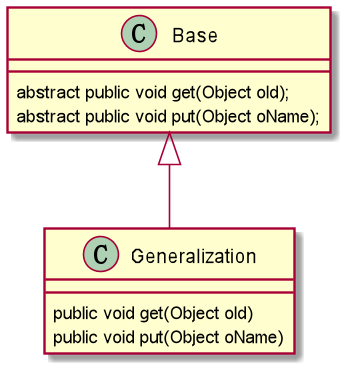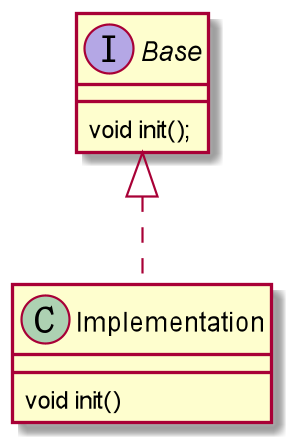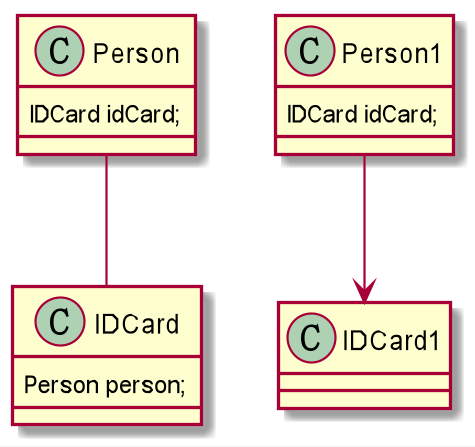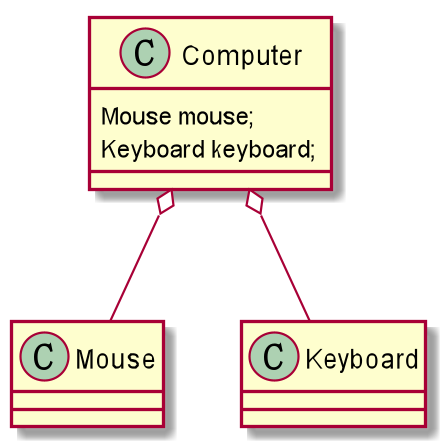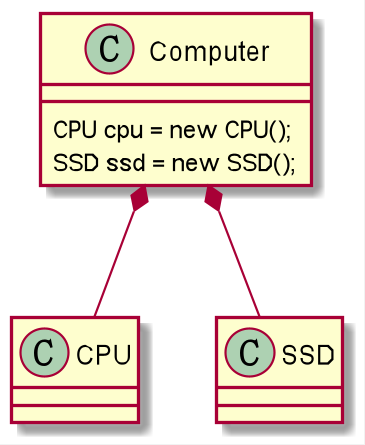设计模式七大原则 设计模式体现了代码的耦合性, 内聚性以及可维护性,可扩展性,重用性,灵活性。
1、代码重用性(即:相同功能的代码,不用多次编写) 2、可读性(即:编程规范性,便于其他程序员的阅读和理解) 3、可扩展性(即:当需要增加新的功能时,非常的方便,称为可维护) 4、可靠性(即:当我们增加新的功能后,对原来的功能没有影响) 5、使程序呈现高内聚,低耦合的特性
Scott Mayers在其巨著《Effective C++》说过: C++老手和C++新手的区别就是前者手背上有很多伤疤。
一、单一职责原则(Single responsibility) 单一职责原则注意事项和细节:
1、降低类的复杂度,一个类只负责一项职责; 2、提高类的可读性,可维护性; 3、降低变更引起的风险 ;4、通常情况下,应当遵守单一职责原则, 只有逻辑足够简单,才可以在方法级违反单一职责原则 。
1 2 3 4 5 6 7 8 9 10 11 12 13 14 15 16 17 18 19 20 21 22 23 24 public class SingleResponsility public static void main (String[] args) Vehicle vehicle = new Vehicle(); vehicle.run("布加迪威龙" ); vehicle.fly("波音747" ); } } class Vehicle public void run (String string) System.out.println(string + ":是陆地交通工具" ); } public void fly (String string) System.out.println(string + ":是空中交通工具" ); } }
二、接口隔离原则(Interface Segregation)
1、类A通过接口 Interface1、2 依赖类B,类C通过接口 Interface1、3 依赖类D,如果接口 Interface 对于 类A 和 类C 来说不是最小接口,那么 类B 和 类D 必须去实现他们不需要的方法。 2、将接口 Interface 拆分为独立的几个接口,类A 和 类C 分别与他们需要的接口建立依赖关系。也就是采用接口隔离原则。 3、接口 Interface 中出现的方法,根据实际情祝拆分为三个接口。
1 2 3 4 5 6 7 8 9 10 11 12 13 14 15 16 17 18 19 20 21 22 23 24 25 26 27 28 29 30 31 32 33 34 35 36 37 38 39 40 41 42 43 44 45 46 47 48 49 50 51 52 53 54 55 56 57 58 59 60 61 62 63 64 65 66 67 68 69 70 71 72 73 74 75 76 77 78 79 80 81 82 83 84 85 86 87 88 89 90 91 92 93 94 95 public class InterfaceSegregation public static void main (String[] args) A a = new A(); a.depend1(new B()); a.depend2(new B()); a.depend3(new B()); C c = new C(); c.depend1(new D()); c.depend4(new D()); c.depend5(new D()); } } interface interface1 void Operation1 () } interface interface2 void Operation2 () void Operation3 () } interface interface3 void Operation4 () void Operation5 () } class B implements interface1 , interface2 @Override public void Operation1 () System.out.println("B 实现了 Operation1" ); } @Override public void Operation2 () System.out.println("B 实现了 Operation2" ); } @Override public void Operation3 () System.out.println("B 实现了 Operation3" ); } } class D implements interface1 , interface3 @Override public void Operation1 () System.out.println("D 实现了 Operation1" ); } @Override public void Operation4 () System.out.println("D 实现了 Operation4" ); } @Override public void Operation5 () System.out.println("D 实现了 Operation5" ); } } class A public void depend1 (interface1 i) i.Operation1(); } public void depend2 (interface2 i) i.Operation2(); } public void depend3 (interface2 i) i.Operation3(); } } class C public void depend1 (interface1 i) i.Operation1(); } public void depend4 (interface3 i) i.Operation4(); } public void depend5 (interface3 i) i.Operation5(); } }
三、依赖倒转原则(Dependence Inversion)
1、高层模块不应该依赖低层模块,二者都应该依赖其抽象(缓冲层);
2、抽象不应该依赖细节,细节应该依赖抽象;
3、依赖倒转(倒置)的中心思想是面向接口编程;
4、依赖倒转原则是基于这样的设计理念:相对于细节的多变性,抽象的东西要稳定的多。以抽象为基础搭建的架构比以细节为基础的架构要稳定的多。在java中, 抽象指的是接口或抽象类,细节就是具体的实现类;
5、使用接口或抽象类的目的是制定好规范,而不涉及任何具体的操作,把展现细节的任务交给他们的实现类去完成。
依赖关系三种传递方式:
接口传递(依赖) 构造方法传递(依赖) setter方式传递(聚合)
1 2 3 4 5 6 7 8 9 10 11 12 13 14 15 16 17 18 19 20 21 22 23 24 25 26 27 28 29 30 31 32 33 34 35 public class DependenceInversion public static void main (String[] args) Person person = new Person(); person.receive(new Email()); person.receive(new WeChat()); } } interface Info String getInfo () ; } class Email implements Info @Override public String getInfo () return "Receive Email" ; } } class WeChat implements Info @Override public String getInfo () return "Receive WeChat" ; } } class Person public void receive (Info info) System.out.println(info.getInfo()); } }
四、里氏替换原则(Liskov Substitution)
1、里氏替换原则(Liskov Substitution Principle)在1988年,由麻省理工学院一位姓里的女士提出;
2、如果对每个类型为T1的对象o1,都有类型为T2的对象o2,使得以T1定义的所有程序P在所有的对象o1都代换成o2时,程序P的行为没有发生变化,那么类型T2是类型T1的子类型。换句话说,所有引用基类的地方必须能透明地使用其子类的对象;
3、在使用继承时,遵循里氏替换原则,在子类中尽量不要重写父类的方法;
4、继承实际上让两个类耦合性增强了,给程序带来侵入性。在适当的情况下,可以通过聚合,组合,依赖来解决问题;
5、继承包含这样一层含义:父类中凡是已经实现好的方法,实际上是在设定规范和契约,虽然它不强制要求所有的子类必须遵循这些契约,但是如果子类对这些已经实现的方法任意修改,就会对整个继承体系造成破坏。
1 2 3 4 5 6 7 8 9 10 11 12 13 14 15 16 17 18 19 20 21 22 23 24 25 26 27 28 29 30 31 32 33 34 35 36 37 38 39 40 41 42 43 44 45 46 47 48 49 50 public class LiskovSubstitution public static void main (String[] args) A a = new A(); System.out.println("2-1=" + a.func1(2 , 1 )); B b = new B(); System.out.println("2+1=" + b.func1(2 , 1 )); System.out.println("2+1+9=" + b.func2(2 , 1 )); System.out.println("B类使用A类方法:2-1=" + b.func3(2 , 1 )); } } class Base public int func1 (int num1, int num2) return num1 - num2; } } class A extends Base } class B extends Base @Override public int func1 (int num1, int num2) return num1 + num2; } public int func2 (int num1, int num2) return func1(num1, num2) + 9 ; } private A a = new A(); public int func3 (int num1, int num2) return this .a.func1(num1, num2); } }
五、开闭原则 OCP(Open Closed)
1、开闭原则(Open Closed Principle) 是编程中最基础、最重要的设计原则; 2、一个软件实体,比如类,模块和函数应该对提供方扩展开放,对使用方修改关闭。用抽象构建框架,用实现扩展细节; 3、当软件需要变化时,尽量通过扩展软件实体的行为来实现变化,而不是通过修改已有的代码来实现变化; 4、编程中遵循其它原则,以及使用设计模式的目的就是遵循开闭原则。
1 2 3 4 5 6 7 8 9 10 11 12 13 14 15 16 17 18 19 20 21 22 23 24 25 26 27 28 29 30 31 32 33 34 35 36 37 38 39 40 41 42 public class OpenClosed public static void main (String[] args) Use use = new Use(); use.drawShape(new Triangle()); use.drawShape(new Circle()); use.drawShape(new OtherGraphics()); } } class Use public void drawShape (Shape shape) shape.draw(); } } abstract class Shape public abstract void draw () } class Triangle extends Shape @Override public void draw () System.out.println("子类实现具体功能:三角形" ); } } class Circle extends Shape @Override public void draw () System.out.println("子类实现具体功能:圆形" ); } } class OtherGraphics extends Shape @Override public void draw () System.out.println("子类实现具体功能:任何形状" ); } }
六、迪米特法则(Demeter)
1、一个对象应该对其他对象保持最少的了解(最少知道原则 LKP)。 2、类与类关系越密切,耦合度越大。要求降低类之间耦合,而不是完全解耦。 3、迪米特法则(Demeter Principle),即一个类对自己依赖的类知道的越少越好。也就是说,对于被依赖的类不管多么复杂,都尽量将逻辑封装在类的内部。对外除了提供public方法,不对外泄露任何信息。 4、迪米特法则更简单的定义:只与直接的朋友通信 。5、直接的朋友:每个对象都会与其他对象有耦合关系,只要两个对象之间有耦合关系,我们就说这两个对象之间是朋友关系。耦合的方式很多,依赖,关联,组合,聚合 等。其中,我们称出现成员变量,方法参数,方法返回值中的类为直接的朋友,而出现在局部变量中的类不是直接的朋友。也就是说,陌生的类最好不要以局部变量的形式出现在类的内部。
1 2 3 4 5 6 7 8 class A B b; public B m1 () public void m2 (B b) public void m3 () B b1 = new B(); } }
1 2 3 4 5 6 7 8 9 10 11 12 13 14 15 16 17 18 19 20 21 22 23 24 25 26 27 28 29 30 31 32 33 34 35 36 37 38 39 40 41 42 43 44 45 46 47 48 49 50 51 52 53 54 55 56 57 58 59 60 61 62 63 64 65 66 67 68 69 70 71 72 73 74 75 76 77 78 79 80 81 82 83 84 85 86 87 88 public class Demeter public static void main (String[] args) SchoolManager schoolManager = new SchoolManager(); schoolManager.printAllEmployee(new CollegeManager()); } } class CollegeEmployee private String id; public String getId () return id; } public void setId (String id) this .id = id; } } class CollegeManager public List<CollegeEmployee> getAllEmployee () List<CollegeEmployee> list = new ArrayList<CollegeEmployee>(); for (int i = 0 ; i < 10 ; i++) { CollegeEmployee emp = new CollegeEmployee(); emp.setId("学院员工id " + i); list.add(emp); } return list; } public void printCollegeEmployee () List<CollegeEmployee> list1 = this .getAllEmployee(); System.out.println("---学院员工----" ); for (CollegeEmployee e : list1) { System.out.println(e.getId()); } } } class SchoolEmployee private String id; public String getId () return id; } public void setId (String id) this .id = id; } } class SchoolManager public List<SchoolEmployee> getAllEmployee () List<SchoolEmployee> list = new ArrayList<SchoolEmployee>(); for (int i = 0 ; i < 5 ; i++) { SchoolEmployee emp = new SchoolEmployee(); emp.setId("学校总部员工id= " + i); list.add(emp); } return list; } void printAllEmployee (CollegeManager sub) sub.printCollegeEmployee(); List<SchoolEmployee> list2 = this .getAllEmployee(); System.out.println("------学校总部员工------" ); for (SchoolEmployee e : list2) { System.out.println(e.getId()); } } }
七、合成复用原则(Composite Reuse) 合成复用原则 尽量使用组合/聚合的方式,而不是使用继承。
1、找出应用中可能需要变化之处,把它们独立出来,不要和那些不需要变化的代码混在一起。 2、针对接口编程,而不是针对实现编程。 3、为了交互对象之间的松耦合设计而努力 。
1 2 3 4 5 6 7 8 9 10 11 12 13 14 15 16 17 18 19 20 21 22 23 24 25 26 27 28 29 30 31 32 33 34 35 36 37 38 39 40 41 42 43 44 45 46 47 48 49 50 51 52 53 54 55 56 57 58 public class CompositeReuse public static void main (String[] args) System.out.println("------依赖------" ); B b = new B(); b.Operation1(new A()); System.out.println("------聚合------" ); b.setA(new A()); b.Operation2(); System.out.println("------组合------" ); b.Operation3(); } } class A void Operation1 () System.out.println("A Operation1" ); } void Operation2 () System.out.println("A Operation2" ); } void Operation3 () System.out.println("A Operation3" ); } } class B void Operation1 (A a) a.Operation1(); a.Operation2(); a.Operation3(); } A a; public void setA (A a) this .a = a; } void Operation2 () a.Operation1(); a.Operation2(); a.Operation3(); } A a1 = new A(); void Operation3 () a1.Operation1(); a1.Operation2(); a1.Operation3(); } }
UML(Unified Modeling Language) IDEA PlantUML表示类与类之间的关系的符号
1 2 3 4 5 6 7 8 9 10 @startuml Class1 <|-- ClassA:泛化 Class2 <-- ClassB:关联 Class3 *-- ClassC:组合 Class4 o-- ClassD:聚合 Class5 <|.. ClassE:实现 Class6 <.. ClassF:依赖 @enduml
依赖(Dependence) 只要是在类中用到了对方,那么他们之间就存在依赖关系。如果没有对方,连编绎都通过不了。
类中用到了对方; 类的成员属性; 方法的返回类型; 方法接收的参数类型; 方法中使用到 。
1 2 3 4 5 6 7 8 9 10 11 12 13 14 15 16 17 18 19 20 21 22 public class Dependence A a; public A save (B b) System.out.println("" ); A a = new A(); return a; } } class A class B
继承(泛化 Generalization) 泛化关系实际上就是继承关系,依赖关系的特例。
1 2 3 4 5 6 7 8 9 10 11 12 13 14 15 16 17 18 public class Generalization extends Base @Override public void get (Object oId) } @Override public void put (Object oName) } } abstract class Base abstract public void get (Object oId) abstract public void put (Object oName) }
实现(Realization) 实现关系实际上就是 A类 实现 B接口,依赖关系的特例。
1 2 3 4 5 6 7 8 9 10 public class Implementation implements Base @Override public void init () System.out.println("init" ); } } interface Base void init () }
关联(Association) 类与类之间的关系,依赖关系的特例。
关联具有导航性:即双向关系或单向关系。
1 2 3 4 5 6 7 public class Person private IDCard idCard; } class IDCard }
聚合(Aggregation) 表示的是整体和部分的关系,整体与部分可以分开,关联关系的特例。
聚合关系是关联关系的特例,所以他具有关联的导航性与多重性。
1 2 3 4 5 6 7 8 9 10 11 12 13 14 15 16 public class Computer private Mouse mouse; private Keyboard keyboard; public void setMouse (Mouse mouse) this .mouse = mouse; } public void setKeyboard (Keyboard keyboard) this .keyboard = keyboard; } } class Mouse class Keyboard
组合(Composite) 整体与部分的关系,但是整体与部分不可以分开,关联关系的特例。
级联删除就是组合关系。
1 2 3 4 5 6 7 8 public class Computer private CPU cpu = new CPU(); private SSD ssd = new SSD(); } class CPU class SSD
感谢阅读
If you like this blog or find it useful for you, you are welcome to comment on it. You are also welcome to share this blog, so that more people can participate in it. If the images used in the blog infringe your copyright, please contact the author to delete them. Thank you !



